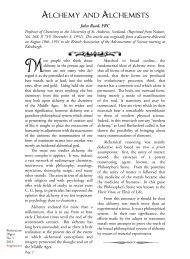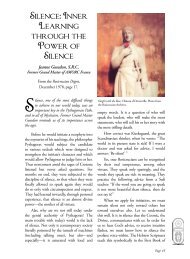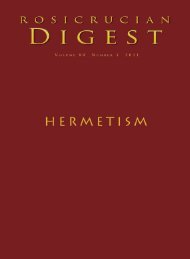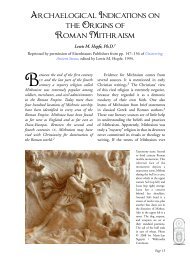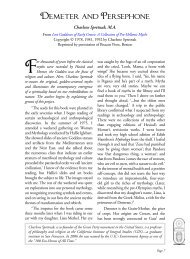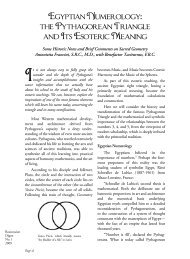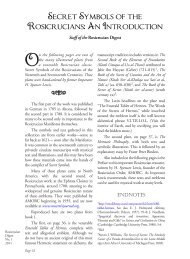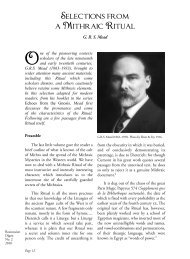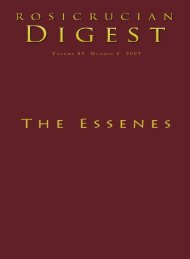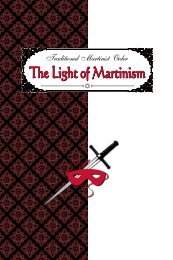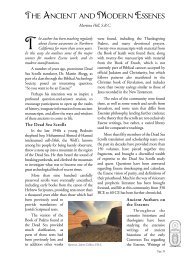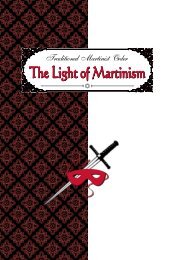Digest - Rosicrucian Order
Digest - Rosicrucian Order
Digest - Rosicrucian Order
Create successful ePaper yourself
Turn your PDF publications into a flip-book with our unique Google optimized e-Paper software.
Christian Rebisse, F.R.C.<br />
From <strong>Rosicrucian</strong> History and Mysteries<br />
<strong>Rosicrucian</strong><br />
<strong>Digest</strong><br />
No. 1<br />
2007<br />
Questions have often arisen regarding<br />
the origins of <strong>Rosicrucian</strong>ism.<br />
Although a consensus of researchers<br />
places its historical beginnings in the<br />
seventeenth century, we are of the opinion<br />
that the genesis of this movement dates from<br />
much farther back. Such was the belief of the<br />
German alchemist Michael Maier. In his<br />
work Silentium Post Clamores (1617), he<br />
described <strong>Rosicrucian</strong>ism as<br />
having arisen from the<br />
Egyptians, the Brahmans, the<br />
mysteries of Eleusis and<br />
Samothrace, the Magi of<br />
Persia, the Pythagoreans, and<br />
the Arabs. Several years after<br />
the publication of the Fama<br />
Fraternitatis (1614) and the<br />
Confessio Fraternitatis (1615),<br />
Irenaeus Agnostus, in Clypeum<br />
veritatis (The Shield of Truth,<br />
1618), felt no hesitation in<br />
declaring Adam to be the first<br />
representative of the <strong>Order</strong>.<br />
The <strong>Rosicrucian</strong> manifestos<br />
likewise made reference to the<br />
same source: “Our philosophy<br />
has nothing new in it; it conforms to what<br />
Adam inherited after the Fall, and what<br />
Moses and Solomon practiced.” 1<br />
The Primordial Tradition<br />
Adam, Egypt, Persia, the Greek sages,<br />
and the Arabs were conjured up for good<br />
reason by Michael Maier. He alluded to a<br />
concept that was very widespread before the<br />
coming of <strong>Rosicrucian</strong>ism. This concept—<br />
the Primordial Tradition—first appeared in<br />
the Renaissance, 2 especially after the<br />
rediscovery of the Corpus Hermeticum, a<br />
group of mysterious texts attributed to an<br />
Egyptian priest, Hermes Trismegistus. From<br />
Page 2<br />
Michael Maier, Symbola<br />
aureae mensae duodecim<br />
nationum, 1617.<br />
him, this idea of a primordial revelation, of<br />
which Egypt was the cradle, would have<br />
considerable repercussions.<br />
Our intention is not to describe Egyptian<br />
esotericism in full, but rather to indicate how<br />
this heritage was transmitted. The route<br />
connecting Egypt to the West is long and<br />
offers a varied landscape. We will not discuss<br />
all of its details, because this description<br />
would occupy an entire<br />
volume. However, certain<br />
salient points will allow us to<br />
understand <strong>Rosicrucian</strong> origins.<br />
While engaging in this<br />
undertaking it is necessary to<br />
follow a trustworthy guide, and<br />
Hermes appears to be the<br />
character most noted in the<br />
ancient writings. Indeed, the<br />
history and myths relating to<br />
this individual are particularly<br />
rich in information concerning<br />
our purpose at hand.<br />
Since antiquity, Egypt’s<br />
civilization has been much<br />
admired. Its mystery schools,<br />
which acted both as universities and<br />
monasteries, were the guardians of its wisdom.<br />
These schools experienced a distinctive<br />
flowering under the rule of Akhnaton (1353–<br />
1336 BCE), especially after he introduced the<br />
concept of monotheism. The Egyptian<br />
religion is particularly intriguing because of<br />
its mysterious cults. Although Hermes had<br />
some of his origins in Egypt, in the god<br />
Thoth, he was primarily a Greek god. He was<br />
the son of Zeus and of the nymph Maia. The<br />
Greeks considered him the god of shepherds,<br />
thieves, merchants, and travelers. He was also<br />
the inventor of astronomy, weights and<br />
measures, the musical scale, the art of




